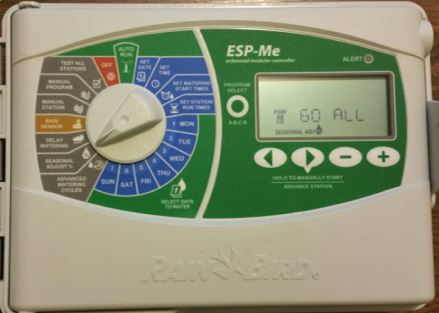Sprinkler Timer, Clock or Controller

Whether your sprinkler timer is new or it has an existing program set, you will need to follow the same steps to make sure the program is operating properly. I would recommend doing this at least once a year.
Step 1, Programs
Start by making sure you are looking at the correct program, A, B, C, a program with a specific name, etc. The program you are currently looking at will be listed somewhere on the display. If this is a new timer, you will just select the first program (most likely program A). If it is a preinstalled timer, you will need to repeat this method for each program, or at least for the programs that are being used.
Step 2, Start Times
Start times are simply the time/s that your sprinkler program starts running during the night or day. YOU MUST HAVE AT LEAST 1 START TIME PER PROGRAM FOR YOUR SYSTEM TO RUN PROPERLY. Start times are generally set sometime between 10pm and 6am. I would recommend selecting only 1 start time, unless you are familiar enough with programming to add more. The most common reasons for having additional start times, growing in seed, sod, garden plants, flowers after initial planting, and controlling runoff for properties with poor soil or long sprinkler run times.
Step 3, Watering Days
Selecting watering days are often strictly controlled by your water department. Make sure you understand the limitations enforced by your local water provider, if there are any. I am fortunate to live in a place where grass and plants have very few problems with disease, so I tend to water 6-7 days a week in the heat of the summer. I have found that I save significantly with more watering days. I apply less water during each cycle of irrigation, but as a whole, I tend to save around 8% using this method. In the spring and the fall, when water demands are low, I tend to only water once or twice a week. In an effort to promote healthy root growth, I tend to start running my sprinkler systems later in the spring than most. I typically won’t start watering until I know seasonal rains are unlikely to provide adequate water, when temperatures are getting warm enough to warrant watering, and when drying out the soil any further will result in damage to the turf or plants. Try using the Run Time Tool provided in the app to help get a base line for watering days and run times.
Step 4, Seasonal Percentage
If your timer has a seasonal percentage, you may want to set it to 100% before making changes to the run times. Seasonal percentage is intended to be set at 100% during the hottest part of the season. You then adjust the percentage as the seasons change, this will change the run times accordingly. For example, July is the hottest month of the summer where I live, so the timer would be set to 100% in July, but May is quite mild, so the seasonal percentage would likely be set to 70% for the month of May.
Step 5, Run Times
Run Times are pretty straight forward to estimate, but difficult to get an exact time. This is because there are so many factors that can effect the overall run time. Some of those factors are, soil type, plant type, wind, humidity, hours of day light, temperature, etc. This is the problem with smart irrigation timers, no matter how complicated they make the system, there is always going to be something not accounted for. I am not saying that smart irrigation is not the answer. Most of the sprinkler timers I maintain are smart timers. For the most part, they do a fabulous job, but there is nothing better than someone on site checking on the outcome.
Possible run times based on the type of head.
- 22 Minutes / Spray Heads
- 40 Minutes / Part Circle Rotors
- 60 Minutes / Full Circle Rotors
- 8 Minutes / Bubblers
- 15 Minutes / Drip Garden
- 55 Minutes / Rotary Nozzles
The times listed above are typical run times for a timer set to run every other day, during the middle of the summer, with temperatures around 85-90 degrees F. This is an approximate industry standard and is a good estimate to start with.